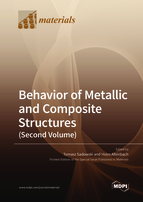Behavior of Metallic and Composite Structures (Second Volume)
A special issue of Materials (ISSN 1996-1944). This special issue belongs to the section "Advanced Materials Characterization".
Deadline for manuscript submissions: closed (28 February 2021) | Viewed by 45405
Special Issue Editors
Interests: continuum damage mechanics of materials and structures; modelling of ceramic polycrystalline materials; modelling of composites: ceramic, metal and polymer matrix, metal and polymer foams, wood and plywood; fracture mechanics of materials under mechanical loading and thermal shock; plates with damage and sandwich structures; experimental testing of materials and structures under: static, cyclic, thermal and impact loading
Special Issues, Collections and Topics in MDPI journals
Interests: continuum mechanics; creep and damage; plates and shells; strength hypotheses; laminates and sandwiches; particle and fibre reinforced plastics; material modeling; method of rheological models; Cosserat theory; higher gradients theories
Special Issues, Collections and Topics in MDPI journals
Special Issue Information
Dear colleague,
Various types of metallic and composite structures are used in modern engineering practice. For aerospace, car industry or civil engineering applications, the most important are thin-walled structures made of different types of metallic alloys, fibrous composites, laminates, and multifunctional materials with a more complicated geometry of reinforcement, including nanoparticles or nanofibres. The current applications in modern engineering require analysis of structures of various properties, shapes, and sizes (e.g., aircraft wings), including structural hybrid joints, subjected to different types of loadings: quasi-static, dynamic, cyclic, thermal, impact, penetration, etc.
Advanced metallic and composite structures should satisfy multiple structural functions during operation conditions. Structural functions include mechanical properties such as strength, stiffness, damage resistance, fracture toughness, damping, etc. Nonstructural functions include electrical and thermal conductivities, sensing, actuation, energy harvesting, self-healing capability, electromagnetic shielding, etc.
The aim of this SI is to understand the basic principles of damage growth and fracture processes in advanced metallic and composite structures, including also structural joints. Today, it is widely recognized that important macroscopic properties, like macroscopic stiffness and strength, are governed by processes that occur at one to several scales below the level of observation. A thorough understanding of how these processes influence the reduction of stiffness and strength forms the key to the analysis of existing and the design of improved innovative structural elements.
The study of how these various length scales—nano, micro, meso—can be bridged or taken into account simultaneously in multiscale models is particularly attractive for composite materials and structural elements, since they have a well-defined structure at the above specified levels.
Prof. Tomasz Sadowski
Prof. Dr. Holm Altenbach
Guest Editors
Manuscript Submission Information
Manuscripts should be submitted online at www.mdpi.com by registering and logging in to this website. Once you are registered, click here to go to the submission form. Manuscripts can be submitted until the deadline. All submissions that pass pre-check are peer-reviewed. Accepted papers will be published continuously in the journal (as soon as accepted) and will be listed together on the special issue website. Research articles, review articles as well as short communications are invited. For planned papers, a title and short abstract (about 100 words) can be sent to the Editorial Office for announcement on this website.
Submitted manuscripts should not have been published previously, nor be under consideration for publication elsewhere (except conference proceedings papers). All manuscripts are thoroughly refereed through a single-blind peer-review process. A guide for authors and other relevant information for submission of manuscripts is available on the Instructions for Authors page. Materials is an international peer-reviewed open access semimonthly journal published by MDPI.
Please visit the Instructions for Authors page before submitting a manuscript. The Article Processing Charge (APC) for publication in this open access journal is 2600 CHF (Swiss Francs). Submitted papers should be well formatted and use good English. Authors may use MDPI's English editing service prior to publication or during author revisions.
Keywords
- Metallic and composite structures
- Multifunctional materials and structures
- Classical structures: beams, plates, shells
- Thin-walled structures
- Damage and fracture processes
- Theoretical analytical and multiscale modeling
- Experimental investigations
- Joints of structural elements
- Quasi-static, dynamic, cyclic loadings
- Impact and penetration








